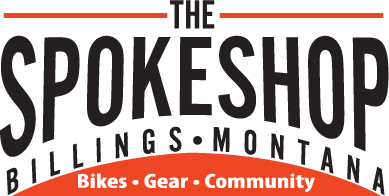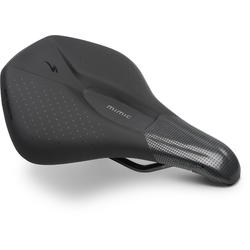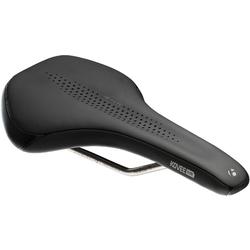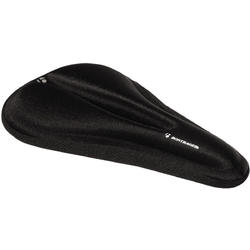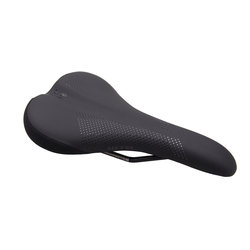Buyer's Guide To Bicycle Seat Types
Bicycling is supposed to be fun, not painful. Yet, it's quite common for even somewhat-experienced cyclists to tolerate saddle discomfort believing it's simply an inevitable part of the sport. Wrong! On the right saddle, you'll be able to enjoy even lengthy rides while hardly noticing your seat at all. The first step, is ensuring that you're on the right type of saddle for how you ride. There are three basic riding positions, with three corresponding seat types: Upright Riding Position Ideal Saddle Type: Cruiser saddle Features: Very wide, fully padded, may include springs or gel Regular Riding Position Ideal Saddle Type: Sport Men's and Women's models Pro Riding Position Ideal Saddle Type: Racing Men's or Women's models Notes: Cyclists who ride fast and hard or for competition require seats suited to their forward position and rapid pedal cadence. Notice how the rider has much of her weight over the handlebars and pedals. She's so far forward you can see that she's resting near the middle of the saddle, too. This means less weight is on the seat, which is why these riders can get by with such minimal designs. Also, it's the perfect position for fast pedaling, for which a narrow saddle like this is ideal. Padding Pointers Come by the store to check out our wide selection of comfortable saddles!
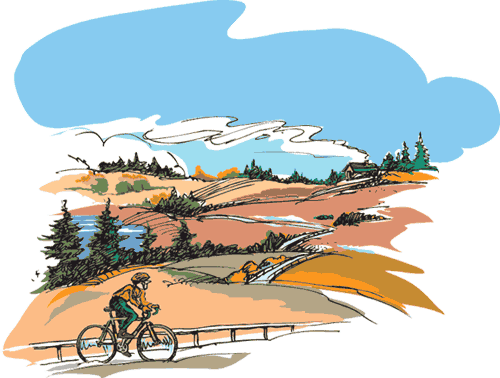
It is true that most brand-new riders or those getting back into cycling, experience a little soreness on the first rides, yet that feeling normally goes away after a few weeks of regular riding as your body gets used to this new activity.
If it doesn't, and if you're suffering every time you hit the road or trail, it's very likely that you're riding on a seat that's not right for you. To help, we explain here what seat types are appropriate for the common types of cycling, and how to choose the right features. Plus, we offer suggestions and tips that have helped our customers solve their seat problems and enjoy truly pain-free rides.
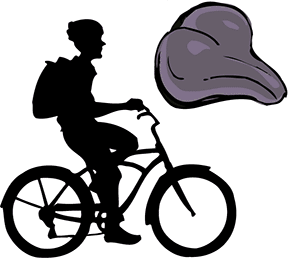
Upright Riding Position
-sitting completely upright, pedaling slowly
-all your weight directly on the seat
-a wide, cushioned seat works best
Ideal Bike Types: Cruiser bikes; some comfort and hybrid bikes
Ideal Riding Style: Casual, leisurely, slow pedaling cadence
Notes: Notice how the rider has almost all of his weight resting over the seat. This makes the wide saddle shown perfect because it offers an ample platform for support and includes plush padding to cushion most of his body weight. Plus, this cyclist pedals at a leisurely to slow pace with his feet slightly ahead of his body, so a little extra seat width doesn't interfere with leg movement.
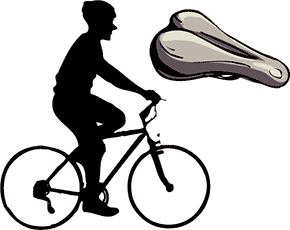
Regular Riding Position
-leaning forward slightly, pedaling fast
-some of your weight supported by handlebars and pedals
-a medium-width, medium-padded seat works best
Features: Anatomic/ergonomic design, may have cutout in top, medium padding (maybe gel), narrow nose, width of rear should match your sit-bone width
Ideal Bike Types: Flat-bar road bike; mountain bike; hybrid bike; city bike; etc.
Ideal Riding Style: Fitness, commuting, pledge rides, touring, all-around road and trail use, medium to fast pedaling cadence
Notes: For recreational riding where you sit upright and lean slightly forward transferring some of your weight to the pedals and handlebars, a medium to narrow saddle with an ergonomic design and a moderate amount of padding is usually best. Riding this type of bicycle you maintain a fast pedal rate and appreciate less width in the nose so it won't interfere with your thighs.
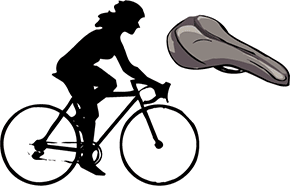
Pro Riding Position
-very forward, pedaling very fast
-weight supported by seat, bars and pedals
-a narrow, lightly padded seat works best
Features: The narrowest and lightest seats, lightly padded, sometimes feature cutouts in the tops, rear width matches your sit bones, may be anatomic/ergonomic
Ideal Bike Types: Road bikes; road-racing bikes; tri bikes; racing mountain bikes
Ideal Riding Style: Fast, fitness, fun, century, race, fast pedaling cadence
One common "test" that often leads to selecting the wrong saddle is the "thumb" test, where you base your purchase on how soft the seat is when you press your thumb into it. If the saddle is for the upright riding position, such as on a cruiser, this test usually works. If you're choosing a seat for longer rides, however, lots of padding probably isn't what you want.
As you ride longer distances, you pedal at a higher pedal rate and remain on the seat more. For this, it's more important that a saddle support your weight than it is for the seat to absorb it. In fact, heavily padded seats usually become uncomfortable the longer you ride because the padding begins to put extra pressure right where you don't want it, which can cause the numbness and pain you were hoping to avoid.
In short, a little padding built into the saddle in the appropriate areas to relieve pressure on sensitive areas works. Squishy, bulky padding that's impressive to the touch usually causes problems if you ride for exercise or distance.
Width Watch
People come in different widths, and saddles do, too. Ideally you'll find a seat with a rear shape that fits the width of your ischial tuberosities, a $50 word for your sit bones. These are the 2 points you feel when sitting on a curb. The right saddle will support and cushion you in just the right spots.
If your sit bones are too wide or narrow for a certain seat, you won't benefit from any of its features because it doesn't fit you correctly. If you have a saddle you've been riding, you can usually see the slight indentations or marks formed right where your sit bones rest, and this gives you a gauge in selecting a new saddle to make sure it's the right width. It's also possible to measure your sit bone width with a ruler and use the measurement to select the right-width saddle.
Your sit bones should be centered over the rear of the saddle. Often there are anatomic bumps in the area for this purpose.
Cutouts & Cutaways
An interesting and effective innovation you'll see in many modern saddles is a cutout or cutaway in the top, which looks like a groove or hole has been cut out of the top of the saddle. The idea is to remove the part of the saddle that's usually responsible for pressuring sensitive tissues and causing numbness and pain.
Different saddle makers have different ideas about the best shape of the cutout and whether it should go all the way through, be a deep groove or maybe just a slight recess. What's important is that you select a saddle that feels right to you. If the cutout is in the wrong spot for your anatomy, it won't do any good. So, it's important to sit on a seat and get a feel for which design works best.
Our Top Tips For Ending Saddle Sores
